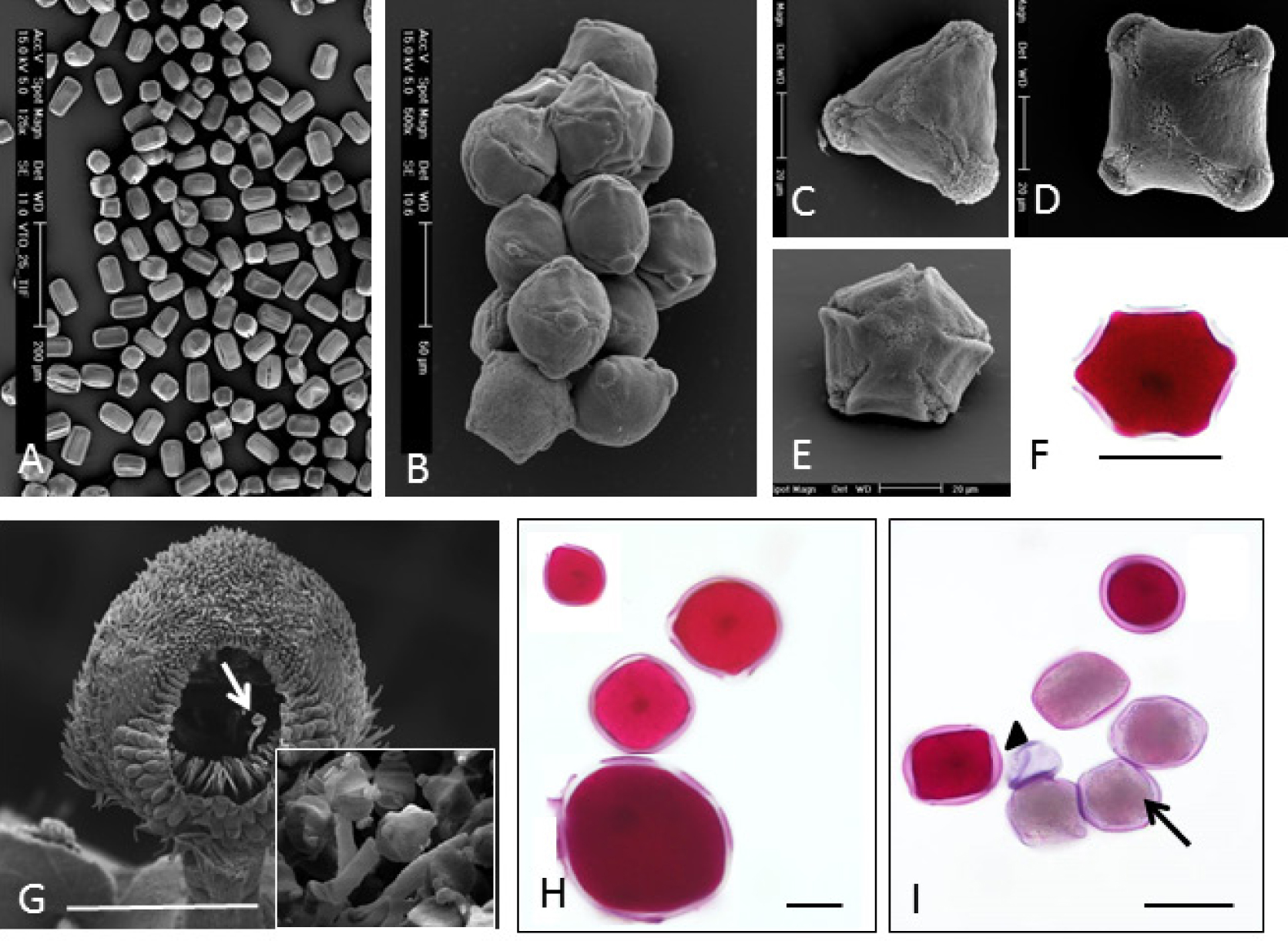Usefulness and limitations of pollen characters in environmental studies based on Viola L. species (sect. Melanium Ging.)
Abstract
The aim of these studies was to determine the effect of environmental pollution on pollen development. Pollen heteromorphism (the presence of pollen morphs differing in aperture number in one flower of a plant), pollen viability (stainability) and pollen grain size in European metallophytes from sect. Melanium Ging. (Viola L., Violaceae) were analyzed by SEM and histochemical staining.
Plants’ tolerance to heavy metals is positively correlated with their pollen viability, which should be termed stainability as it depends on the staining method applied and is not correlated with pollen germination. Abortive pollen can be produced as an effect of heavy metals but also may result from hybridization, a very common phenomenon in pansies. Pollen stainability in hybrids can be high (even exceeding 70%) or low (barely above 20%), and stainable pollen grains can differ greatly in size (from very small to giant), indicating a cytological imbalance resulting from disturbed meiosis. The number of pollen apertures is an adaptive character in facultative metallophytes. Plants from a metallicolous population produced a wider range of aperture number (3, 4, 5) than plants from a non-metallicolous population, which developed only 4- and 5-aperturate pollen. Three-aperturate longer-lived pollen are favored in the harsh conditions of a metal-polluted environment.
References
Bothe H., Vogel-Mikuš K., Pongrac P., Likar M., Stepic N., Pelicon P., Vavpetič P., Jeromel L., Regvar M. 2013. Metallophyte status of violets of the section Melanium. Chemosphere 93: 1844–1855.
Erben M. 1996. The significance of hybridization on the forming of species in the genus Viola. Bocconea 5: 113–118.
Hildebrandt U., Hoef-Emden K., Backhausen S., Bothe H., Bożek M., Siuta A., Kuta E. 2006. The rare, endemic zinc violets of Central Europe originate from Viola lutea Huds. Plant Syst. Evol. 257: 205–222.
Izmaiłow R. 2000. Reproduction of Vicia cracca L. in the polluted environment of the Legnica-Głogów Copper Basin (Poland). Acta Biol. Cracov. Ser. Bot. 42: 125–133.
Mičieta K., Murin G. 1996. Microspore analysis for genotoxicity of a polluted environment. Environ. Exp. Bot. 36: 21–27.
Nadot S., Ballard H.E., Creatch J.B., Dajoz I. 2000. The evolution of pollen heteromorphism in Viola: A phylogenetic approach. Plant Syst. Evol. 223: 155–171.
Pilarska M., Kuta E. 2005. Reproductive processes in the yellow zinc violet (Viola lutea Huds. ssp. calaminaria (Ging.) Nauenb.) – a metal-tolerant taxon. Acta Biol. Cracov. Ser. Bot. 47 (suppl. 1): 30.
Ressayre A., Mignot A., Siljak-Yakovlev S., Raquin C. 2003. Postmeiotic cytokinesis and pollen aperture number determination in eudicots: effect of the cleavage wall number. Protoplasma 221: 257–268.
Saini H.S. 1997. Effects of water stress on male gametophyte development in plants. Sex. Plant Reprod. 10: 67–73.
Siuta A., Bożek M., Jędrzejczyk M., Rostański A., Kuta E. 2005. Is the blue zinc violet (Viola guestphalica Nauenb.) a taxon of hybrid origin? Evidence from embryology. Acta Biol. Cracov. Ser. Bot. 47: 237–245.
Słomka A., Jędrzejczyk-Korycińska M., Rostański A., Karcz J., Kawalec P., Kuta E. 2012. Heavy metals in soil affect reproductive processes more than morphological characters in Viola tricolor. Environ. Exp. Bot. 75: 204–211.
Słomka A., Kawalec P., Kellner K., Jędrzejczyk-Korycińska M., Rostański A., Kuta E. 2010. Was reduced pollen viability in Viola tricolor L. the result of heavy metal pollution or rather the test applied? Acta Biol. Cracov. Ser. Bot. 52: 123–127.
Słomka A., Kuta E., Pilarska M., Kellner K., Kawalec P., Bohdanowicz J. 2008. Pollen heteromorphism in wild and ornamental pansies (Sect. Melanium, Violaceae). Acta Biol. Cracov. Ser. Bot. 50 (suppl. 1): 18.
Słomka A., Kuta E., Szarek-Łukaszewska G., Godzik B., Kapusta P., Tylko G., Bothe H. 2011. Violets of the section Melanium, their colonization by arbuscular mycorrhizal fungi and their occurrence on heavy metal heaps. J. Plant Physiol. 168: 1191–1199.
Till-Bottraud I., Vincent M., Dajoz I., Mignot A. 1999. Pollen aperture heteromorphism. Variation in pollen-type proportions along altitudinal transects in Viola calcarata. C.R. Acad. Sci. Paris, Life Sci. 322: 579–589.


This work is licensed under a Creative Commons Attribution-NonCommercial-NoDerivatives 4.0 International License.
The journal is licensed by Creative Commons under BY-NC-ND license. You are welcome and free to share (copy and redistribute the material in any medium or format) all the published materials. You may not use the material for commercial purposes. You must give appropriate credit to all published materials.
The journal allow the author(s) to hold the copyrights and to retain publishing rights without any restrictions. This is also indicated at the bottom of each article.





